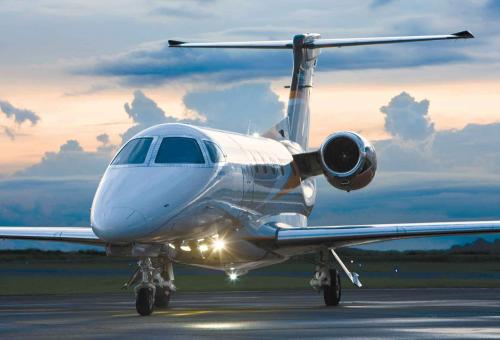
Embraer's Phenom 300
"I think the 300 might be a home run."
Embraer entered the light jet market in 2005, promising more for less, and the $8.14 million Phenom 300 delivers. It's fast, has long legs and sports a well-equipped, comfortable cabin with an array of options typically found only in airplanes costing millions more. The Phenom 300 was certified late last year. It can be flown single-pilot, boasts a range of nearly 2,000 nautical miles, has a maximum speed of 453 knots and climbs to a ceiling of 45,000 feet in just 26 minutes.
The 300 seems likely to take market share from the more expensive Bombardier Learjet 40XR and the Cessna Citation CJ4. It may also dissuade Hawker Beechcraft from launching the Hawker 450XP, the long-awaited successor to the venerable Beechjet. In marketing parlance, the Phenom 300 is a category killer.
"It delivers all the things Embraer said it would," commented Terry Vance, the retired motorcycle drag-racing champion who now runs several motorcycle-related ventures. He took delivery of the second U.S.-based Phenom 300 at the end of January and had flown on it 115 hours by the end of June. Vance said the 300 has the potential to become an iconic aircraft. "From a customer-satisfaction standpoint, Embraer has just made the '55 Chevy," he said. "I think the 300 might be a home run."
Embraer delivered the first U.S. Phenom 300 last December to Executive Flight Service, which operates it on a Part 135 charter certificate on behalf of a Texas customer. EFS's sister company, Executive AirShare, is selling fractional shares in the airplane and has six on order. Adam Letts is EFS's vice president of operations and, as pilot in command, has logged about 127 hours in the aircraft. He said the 300 is "about 98 percent of the way to the perfect airplane."
Vance and Letts agree that the Phenom 300 is a game-changer, with more passenger legroom and 20 percent less fuel burn than a Beechjet, a sustained 4,000-foot-per-minute climb rate and brakes that can stop the aircraft in as little as 2,200 feet after touch down. Operators said the stopping power was impressive even though the Phenom 300 lacks thrust reversers and the full flaps setting is limited to 26 degrees.
Embraer called that limitation temporary and reported that the aircraft will soon be certified for an additional notch of flaps and steep approaches into places like London City Airport. Meanwhile, if you want to take your Phenom 300 into mountainous airports, your pilot needs to bring his A game. The reason: The flap-setting limitation, combined with the aircraft's slick wing, makes it loathe to slow and renders approaches into places like Aspen a bit tricky. "You've got to really plan ahead," said Letts. "At the top of the approach at power idle going into Aspen or other high-terrain areas, we are building up too much speed."
Inside the Phenom 300's cabin, Embraer offers a generous selection of options for an aircraft in the light-jet category. Basic available color pallets include agate, citrine, obsidian, onyx, quartz, topaz, and tourmaline; however, customers can select fabric and color combinations beyond these offerings. Cabins feature enclosed, pleated window shades; Ultraleather upper sidewalls; carpet or wood floors; laminate, gloss or veneer cabinet finishes; and carpeted or fabric-covered lower sidewalls. In-flight entertainment options include satellite radio, seat power outlets, audio source for mp3 players, speakers, subwoofers and a VIP control panel. There are separate passenger and cockpit environmental controls.
The 18-inch-wide cabin seats feature longitudinal tracking, adjustable recline, three-point seatbelts, breakover backs and inboard armrests. Maximum seat pitch is 42 inches.
The cabin's cool, clean lines and appearance are reminiscent of upscale automobiles. That's no accident. For interior design, Embraer turned to BMW DesignWorksUSA in Newbury Park, Calif.
The 300 comes in two basic floor plans that accommodate six to nine passengers and customers can choose between a full wardrobe or a sink in the externally serviced lavatory. The 300's galley can be equipped with a hot jug and a wine rack. The large baggage hold can carry golf clubs and skis.
Despite its BMW influence, the 300's cabin isn't as refined as the one you'll find on Cessna's CJ4, perhaps belying Embraer's lineage as a commercial airline builder. Letts knocked the passenger seats for their "ratchety" adjustment functions, although he said seat comfort is adequate. Vance said the seats should have better armrests. Embraer is reportedly working with its seat supplier to improve them.
Letts also pointed out that in-flight entertainment input jacks are only in the cockpit, not in the cabin, and that the main cabin lighting and lavatory lights are all on the same circuit-there is no separate lavatory lighting switch.
An Embraer spokesman said the company was looking into these items. Those minor criticisms aside, operators seem happy with the 300's cabin. Letts called it "comfortable, quiet and spacious" and added, "Passengers really like it."
How well the Phenom 300 eventually does in the market may have less to do with the aircraft's performance than with how well the manufacturer supports it, said Vance. "The Embraer guys are in a sweet spot if they maintain the customer service they need to maintain," he commented. "That is the real key.

